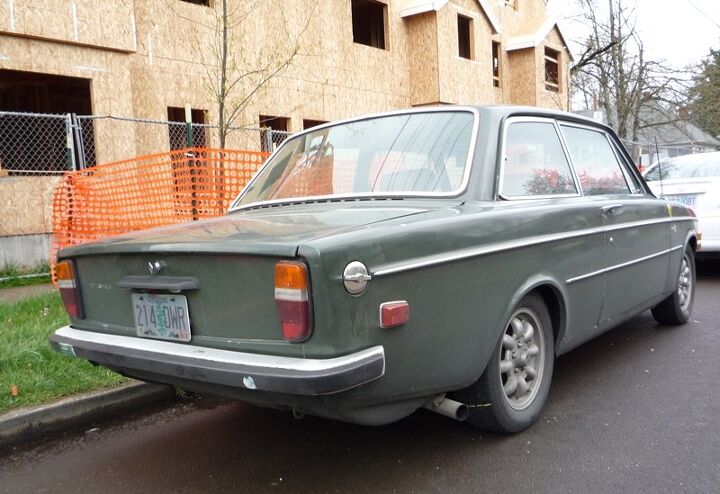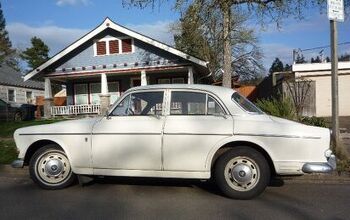Curbside Classic: 1968 Volvo 142 S

Since we overdosed on Eugene-mobiles yesterday, we’re going to have to hold off on that other definitive official local car, the Volvo 240 series until we’ve recuperated and the flashbacks die down a bit. But we’ve given Volvo short shrift here, so let’s do a car that takes me straight back to Maryland circa 1968, but in the most positive way possible: a 142S, decked out just like a young enthusiast of the times (me!) would have done (minus the non-vintage lip spoiler). This is a car that I seriously lusted after then, and it still works on my limbic system today.
My older brother’s friend was in a position to buy a new car in 1968, to replace his hand-me-down 1962 Buick Special. He considered a Mercedes 190, but it was too poky. Why the BMW 1600/2002 wasn’t on his list is beyond me. But when he showed up with a bright red 144S, I was momentarily taken aback, but quickly jealous.
The Volvo 140 series was the seminal modern Volvo. Sure, the earlier 544 and 122 had deep roots in the a certain segment of the import market on the coasts, but the crisp boxy Scan-design of the 140 broke Volvo through to a whole new level sales and acceptability. By the early seventies, car-conservative Maryland was crawling with these. The Volvo was making serious inroads with a demographic that was highly desirable: youngish and well educated. And forget about all the stereotypes of Birkenstock-wearing granola crunchers: these were lawyers and other professionals wearing button-downs.
Of course it was a cultural trend to drive imports on the coasts, one that eventually became a tidal wave. But the Volvo’s appeal went beyond being a fad, given its rugged build yet stylish (for the times) body and tasteful Swedish-style interior. And that clean boxy styling, which looked pretty modern when it first appeared in 1969, wore incredibly well with time, especially considering how bulbous, swollen and ridiculous most American cars got during the seventies. The Volvo 140 series was the perfect antithesis to them, and its stylistic continuity through the 240 series made it the equivalent of what the VW Beetle had been in earlier decades. In fact, if there ever was a true spiritual successor to the Beetle, it was the Volvo 140/240. And given that incomes were rising, it’s not a stretch to assume that a lot of Volvo’s buyers were former VW drivers.
But in addition to the then-newly emerging Yuppies, Volvo had a loyal enthusiast following. Vovo’s lusty-sounding fours with the twin SU carbs hanging off the sides were pretty consistently faster than most of the more modestly powered imports. Handling was crude but effective. And it was all easy to work on, fix or modify. And they held up to the abuse young enthusiasts were prone to inflict on their cars.
My brother’s friend drove the snot out of his new 117 hp 144S, from the day he picked it up at the dealer and took us for a ride: memorable, but clearly not in observance of the break-in recommendations of the times. Eventually, it sported a noiser exhaust, and some Minilite wheels just like this. The back roads of northern Baltimore County made a perfect playground, and there was not even a thought of my brother’s tired MGA being able to keep up with the Volvo.
Speaking of MG’s, Volvos always had a distinctly British flavor, from the roarty pushrod fours, SU carbs, simple RWD chassis, and overdrives. The Volvo was the sedan counterpart to the MGB; they sounded and handled remarkably similar.In fact, my brother’s other friend had a mildly worked-over MGB, and the similarities struck me one day as the 144S and B raced each other one day. And although the Brits made a number of sedans with the same formula, the execution was always a let down, especially as time went on. Volvo probably mopped up the lion’s share of MG and Triumph owners needing a back seat.
When I saw this 142s, with its wheels and missing front bumper near the campus, it exerted a its powerful time machine effect on me. And here is a student driving this one in 2010, exactly like his dad might have driven to the University of Maryland forty years ago. What are the odds his kid will be driving a 2010 Volvo in 2050? More likely, he’ll be driving dad’s hand-me-down 142S.

More by Paul Niedermeyer
Latest Car Reviews
Read moreLatest Product Reviews
Read moreRecent Comments
- Wjtinfwb My comment about "missing the mark" was directed at, of the mentioned cars, none created huge demand or excitement once they were introduced. All three had some cool aspects; Thunderbird was pretty good exterior, let down by the Lincoln LS dash and the fairly weak 3.9L V8 at launch. The Prowler was super cool and unique, only the little nerf bumpers spoiled the exterior and of course the V6 was a huge letdown. SSR had the beans, but in my opinion was spoiled by the tonneau cover over the bed. Remove the cover, finish the bed with some teak or walnut and I think it could have been more appealing. All three were targeting a very small market (expensive 2-seaters without a prestige badge) which probably contributed. The PT Cruiser succeeded in this space by being both more practical and cheap. Of the three, I'd still like to have a Thunderbird in my garage in a classic color like the silver/green metallic offered in the later years.
- D Screw Tesla. There are millions of affordable EVs already in use and widely available. Commonly seen in Peachtree City, GA, and The Villages, FL, they are cheap, convenient, and fun. We just need more municipalities to accept them. If they'll allow AVs on the road, why not golf cars?
- ChristianWimmer Best-looking current BMW in my opinion.
- Analoggrotto Looks like a cheap Hyundai.
- Honda1 It really does not matter. The way bidenomics is going nobody will be able to afford shyt.






































Comments
Join the conversation
So, everybody loves them. Why don't they bring any money??? I'd be suprised if this one would bring more than $2,000. where as a same year Alfa or Lancia would bring 5 times that.
Is this dashboard stock??